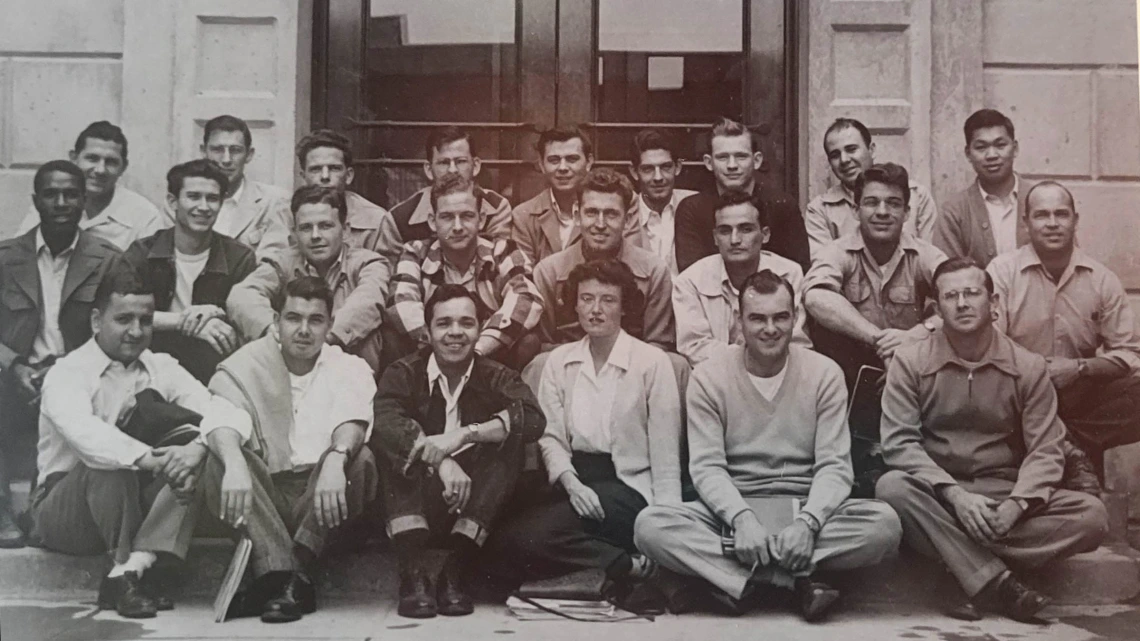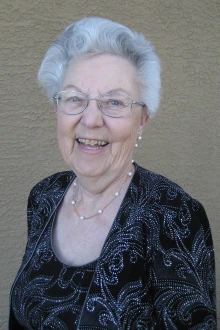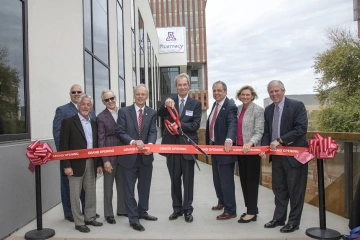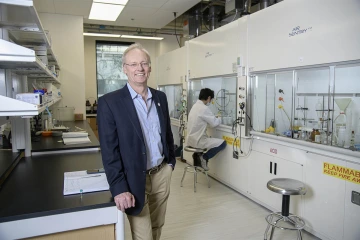Coit College of Pharmacy Celebrates Diamond Anniversary
From humble beginnings, the R. Ken Coit College of Pharmacy has come a long way over the last 75 years.

The University of Arizona R. Ken Coit College of Pharmacy’s first class graduated with bachelor’s degrees in pharmacy in 1950. The college celebrates its 75th anniversary this fall.
The R. Ken Coit College of Pharmacy has seen many changes since opening its doors for the first time on the University of Arizona campus 75 years ago, from 25 students and three faculty members – nearly all male – to women comprising about 60% of each class, two expanding buildings and one of the leading pharmacy programs in the country.
The UArizona School of Pharmacy opened on Sept. 1, 1947 with Rufus Lyman, MD, at the helm as dean. At the time, students completed their instruction in a surplus Army hut. Dr. Lyman guided the school to become a full-fledged college on July 1, 1949, then retired almost immediately after the first class graduated with bachelor’s degrees in June 1950.
A decade of firsts
The 1950s saw a lot of milestones. Within the inaugural class, the average age was 27 and the first and only female graduate was Anna Catherine Ward. Nearly all of the graduates were World War II veterans, and more than half of the students were married with at least one child in the family. Most were also Arizona residents.

Albert L. Picchioni, PhD, provides a phone consultation using one of 2,000 index cards he created with information on chemicals and their health effects. Dr. Picchioni, professor and acting dean of the college from 1975-1977, created the Arizona Poison Control System, a precursor to the Arizona Poison and Drug Information Center.
A five-year curriculum leading to a Bachelor of Science degree in pharmacy, the first in the country, was approved by the Arizona Board of Regents in September 1951.
In 1953, professor Albert L. Picchioni, PhD, created the Arizona Poison Control System, the state’s first poison center – and only the second of its kind in the nation – at the college. Dr. Picchioni and colleagues developed a database of 2,000 index cards at the request of pediatricians whose patients were being harmed accidentally by household cleaning products. Through the Poison Control System, information on chemicals and their effects on health were distributed to hospitals across the state.
The Poison Control System was the precursor of the Arizona Poison and Drug Information Center, the college’s first Center of Excellence, which was established in 1980 with funding from the Arizona Legislature.
In 1959 under the guidance of Willis R. Brewer, PhD, a professor of pharmacognosy and the youngest person ever appointed dean at the university at the age of 33, the college expanded to include doctoral programs in pharmaceutical chemistry and pharmacology.
Changing demographics

(From left) In a 1985 photo, College of Pharmacy alumna Metta Lou Henderson, PhD, stands with mentor and pharmacy research professor Mary Caldwell, PhD, and Myrdas and Willis R. Brewer, PhD, dean of the college from 1952 to 1975.
Women comprised 9% of graduating classes from 1950 to 1972, though the college was a welcoming environment for women, according to Metta Lou Henderson, PhD, who completed bachelor’s, master’s and doctoral degrees in pharmacy at UArizona in 1961, 1966 and 1978, respectively.
“There were four women in my undergraduate class, two were married and two of us were single. Married women in college were not that common back then,” said Dr. Henderson, who has been a research professor at the college since 2008. “I really had no problems; we were treated the same by the faculty. We were encouraged to do anything we wanted to do. My class was half Korean War vets who were all married, and they all had children. They teased the living daylights out of us, but they wouldn’t let anybody outside of pharmacy look at us cross-eyed.
“When I came back to do my master’s degree, I was the only female in the graduate program. I was also the first woman to get a master’s from the college, and I was the first to get a PhD.”

Dr. Henderson graduated with a bachelor’s in 1961, a master’s in 1966 and a doctorate in 1978. She has been a research professor at the college since 2008.
In 1973, the number of women enrolled rose to double digits and never stopped growing. A major turning point took place a decade later when women began outnumbering men. In 1981, 33% of graduates were women, compared with 57% in 1982.
Today women graduates from the College of Pharmacy still outnumber men in a trend that mirrors other pharmacy colleges nationally.
Pharmacy gets its own space
The decades from 1970 to 2000 were a significant period in the college’s evolution. Dean Jack R. Cole, PhD, the first alumnus (Class of 1953) to be appointed dean at the college, campaigned for a new building to be located at the Arizona Health Sciences Center. Dr. Cole secured a $1 million grant from the Skaggs Companies Inc., and construction began in 1979.
The Skaggs Pharmaceutical Sciences Center opened in 1982 and has been the site of numerous research successes since then, including licensing a small-molecule drug aimed at shortening the lives of cancer cells, developing therapies for Alzheimer’s disease and Down syndrome and the pre-clinical development of a promising antiviral drug for influenza.

(From left) J.P. Roczniak, University of Arizona Foundation President and CEO; donor Richard Katz; donor R. Ken Coit; Rick Schnellmann, PhD, dean of the Coit College of Pharmacy; Ronny Cutshall, president of The ALSAM Foundation; Michael D. Dake, MD, senior vice president for the University of Arizona Health Sciences; Liesl Folks, PhD, MBA, University of Arizona Provost; and University of Arizona President Robert C. Robbins, MD, perform a ribbon-cutting to open the renovated and expanded Skaggs Center on Feb. 21, 2020.
The 1980s also brought with it changes to the academic degrees offered at the college. The Arizona Board of Regents approved a Doctor of Pharmacy degree (PharmD) in 1981. As of 2022, more than 4,000 students have graduated from the college.
In 1985, I. Glenn Sipes, PhD, head of the Department of Pharmacology and Toxicology began coordinating a new institute, the Center for Toxicology. This center has grown to include the Superfund Basic Research Program and the Southwest Environmental Health Sciences Center, which launched in 1994, to research the environmental health risks and disease among people living in arid environments undergoing climate change. It has also facilitated community outreach and engagement opportunities for diverse populations in the Southwest, including Native American, Hispanic and Latino, and rural communities, teaching people how to sustain an environmentally friendly quality of life and educating them on potential environmental health risks. Graduate and doctoral students have had opportunities to work alongside faculty including Georg Wondrak, PhD – recipient of the inaugural R. Ken and Donna Coit endowed professorship – on research focused on environmental exposure to ultraviolet radiation and skin cancer.
The Center for Health Outcomes and PharmacoEconomic Research (HOPE) was established in 1986. Through HOPE, researchers, academic institutions, health care organizations and pharmaceutical firms worldwide collaborate to assess health care practices and interventions from a clinical, economic and humanistic view.
New millennium brings transformations
Strong growth continued into the new millennium and once again expansion was necessary. In 2006, the college moved into Roy P. Drachman Hall-Pulido Center, a building it shares with the UArizona Mel and Enid Zuckerman College of Public Health. In 2007, the college opened a Phoenix location on the Phoenix Bioscience Core. In 2014, the college welcomed its first three virtual PharmD students, who attended via live videostream from Tucson.
“The future of our college is bright and full of promise.”
Dean Rick G. Schnellmann, PhD
In 2016, Dean Rick G. Schnellmann, PhD’s first year as head of the college, he created a challenge to raise $26 million to fund the expansion of the Skaggs Pharmaceutical Sciences Center. Construction began two years later, and the Skaggs addition officially opened in 2020.
“The expansion allows the College of Pharmacy to remain on the forefront of drug discovery, pharmaceutics, pharmacology and toxicology research, and provide current and future pharmacy students more opportunities to assist in reshaping the future of health care and treatment,” Dean Schnellmann said.
The newest Center of Excellence, the Arizona Center for Drug Discovery, was established in 2019. The center advances drug discovery throughout the state by connecting UArizona researchers in Tucson and Phoenix with pharmaceutical partners. Twice a year, the center and the UArizona Cancer Center host the Drug Discovery and Development Summit, which brings together scientists and industry professionals to highlight key areas of research aimed at treating diseases prevalent in Arizona.

Dean Schnellmann stands in a chemistry laboratory in the Skaggs building in February 2020.
The Arizona Poison and Drug Information Center continues to grow. In 2021, the center received 87,217 calls from across Arizona. Center workers and volunteers answered questions about poison and drug exposures and provided information about poison prevention and safe and proper use of medications, as well as offering consultations with physicians and health professionals. During the COVID-19 pandemic, the center fielded hundreds of calls per week and sometimes hundreds per day – on a hotline dedicated to questions about the coronavirus.
Looking ahead, the college is already undergoing a transformation thanks to R. Ken Coit’s 2021 gift of $50 million that renamed the college in his honor. The endowment establishes six endowed chairs in drug discovery, neurodegenerative diseases and toxicology, as well as scholarships for the college’s doctoral programs and a new Coit Museum of Pharmacy & Health Sciences.
“The future of our college is bright and full of promise,” Dean Schnellmann said. “We are well positioned to respond and address future health care challenges. The Arizona Center for Drug Discovery and the upcoming launch of our newest center – the Coit Center for Longevity and NeuroTherapeutics – are the linchpin of these efforts.”

